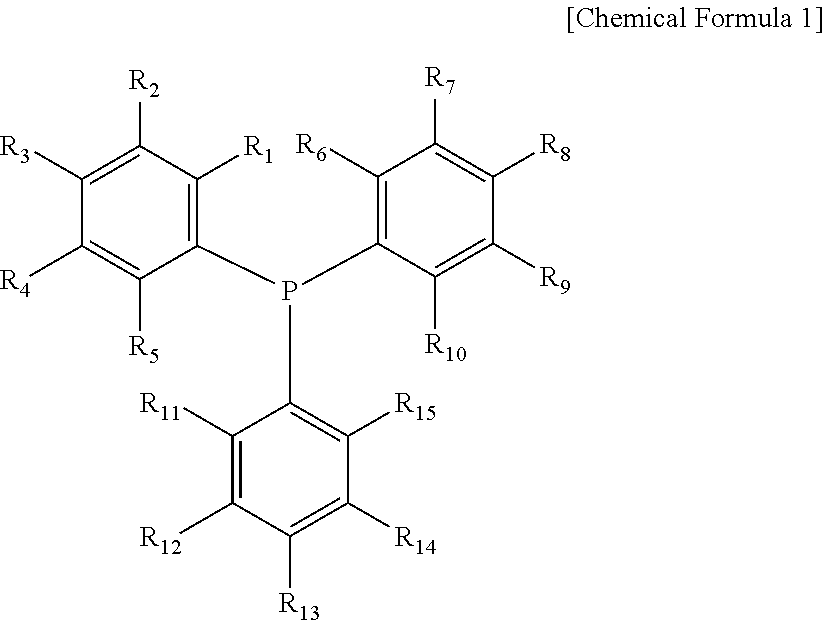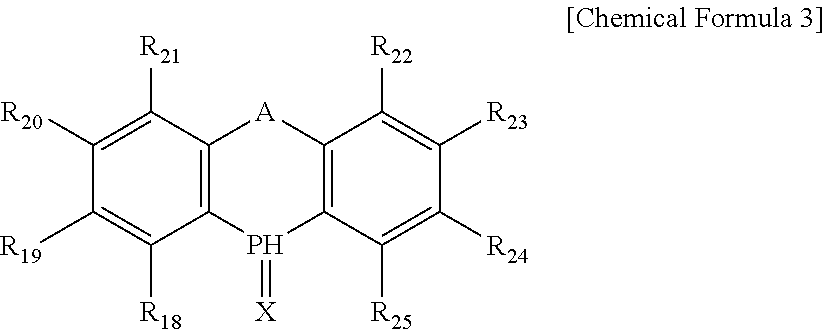Catalyst composition for hydroformylation and method for producing aldehyde using the same
a technology of hydroformylation and catalyst composition, which is applied in the direction of organic compound/hydride/coordination complex catalyst, physical/chemical process catalyst, group 5/15 element organic compound, etc., can solve the problems of affecting the activity of catalyst, few ligands that can be expected, and the price of catalyst, etc., to achieve excellent stability, high catalyst activity, and high selectivity
- Summary
- Abstract
- Description
- Claims
- Application Information
AI Technical Summary
Benefits of technology
Problems solved by technology
Method used
Image
Examples
example
1. N / I Selectivity and Activity of the Catalyst in Hydroformylation
examples 1 to 13
[0086]0.101 g (0.205 mmol) of acetylacetonatocarbonyltriphenylphosphinerhodium{[Rh(AcAc)(CO) (TPP)]:ROPAC} as a catalyst, TPP that is a triaryl phosphine compound (L1), and the following Ligand I, Ligand II, Ligand III, Ligand IV, Ligand V or Ligand VI that are a phosphine oxide or phosphine sulfide compound (L2) that were dissolved in a normal-butyraldehyde solvent, were added to an autoclave reactor of 600 ml volume to be 100 g of the total solution. Propylene and synthesis gas (CO / H2) (mixed ratio of CO and H2=1:1) were injected into the reactor to maintain 6 bar of pressure in the reactor, and reacted for 1.5 hours while stirring.
[0087]
TABLE 3Ligand IDiphenylphosphine oxideLigand IIBis(4-methoxyphenyl)phosphine oxdieLigand IIIBis(phenylphosphinoyl)benzeneLigand IVDiphenylphosphine sulfideLigand V2,8-Dimethylphenoxaphosphine oxide
[0088]The transition metal catalyst to the above reaction, the types of ligands, the mole ratio of the ligands to the catalyst, N / I selectivity and the ...
examples 14 to 24
[0092]0.05 g (0.194 mmol) of acetylacetonatocarbonylrhodium{[Rh(AcAc)(CO)2]:Rh(AcAc)} as a catalyst; TPP, TMSTP, DPMPP, TDMPP, TPTP or TMPP that is a triaryl phosphine compound (L1); and the following Ligand I or Ligand III that is a phosphine oxide compound (L2) that were dissolved in a normal-butyraldehyde solvent, were added to an autoclave reactor of 600 ml volume to be 100 g of the total solution. Propylene, and hydrogen and CO were injected to be 1:0.85:0.75. A condenser with BPR (BACK PRESSURE REGURATOR) was installed in the upper part of the reactor so that a certain part of non-reactive gas may be out of the reactor and H2 / CO partial pressure in the reactor can regularly be maintained. While the total pressure was maintained to be 8 bar in the reactor and the solution in the reactor was stirred at 90° C., the reaction was performed for 1.5 hours.
[0093]The transition metal catalyst to the above reaction, the types of ligands, the mole ratio of the ligands to the catalyst, N / ...
PUM
| Property | Measurement | Unit |
|---|---|---|
| temperature | aaaaa | aaaaa |
| pressure | aaaaa | aaaaa |
| temperature | aaaaa | aaaaa |
Abstract
Description
Claims
Application Information
 Login to View More
Login to View More - R&D
- Intellectual Property
- Life Sciences
- Materials
- Tech Scout
- Unparalleled Data Quality
- Higher Quality Content
- 60% Fewer Hallucinations
Browse by: Latest US Patents, China's latest patents, Technical Efficacy Thesaurus, Application Domain, Technology Topic, Popular Technical Reports.
© 2025 PatSnap. All rights reserved.Legal|Privacy policy|Modern Slavery Act Transparency Statement|Sitemap|About US| Contact US: help@patsnap.com



